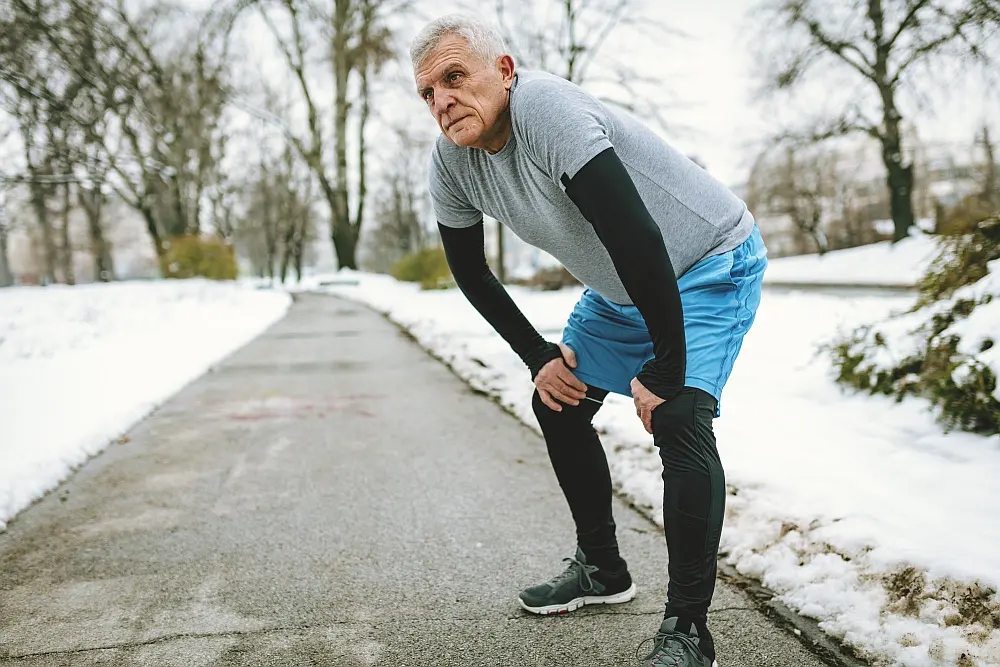If you want to reduce joint pain, especially in cold conditions, do the following right away:
- Keep Warm: Wear proper clothing and use heating pads to keep the affected joints warm.
- Stay Active: Perform mild workouts to keep joints flexible and stiffness at bay.
- Hydrate: Drink plenty of water to keep your joints lubricated and prevent friction.
- Consider Supplements: To maintain joint health, see a healthcare practitioner about supplements such as Omega-3 fatty acids or Vitamin D.
For many people, the winter chill causes an increase in joint pain. This link between cold weather and joint discomfort is intriguing, with scientific complexity at its base.
Why Does Cold Weather Make Joint Pain Worse?
The link between joint pain and cold temperatures is still somewhat unclear. Several explanations, however, have been proposed to explain this occurrence. One such notion is that fluctuations in barometric pressure cause the tendons and tissues surrounding the joints to expand and compress, creating discomfort or agony. Furthermore, cold weather constricts blood vessels, limiting blood flow to the extremities and potentially exacerbating joint discomfort.
Scientific Perspectives on Winter Joint Pain
Colder temperatures cause joint fluid to thicken, reducing its lubricating properties and causing increased friction between joints, resulting in discomfort, particularly for people suffering from illnesses such as arthritis. Furthermore, decreased blood circulation as a result of the body’s reaction to cold weather might limit the availability of nutrients to joints, exacerbating discomfort.
Knees, hips, and shoulders are often the joints that feel the coldest in the winter, becoming stiffer and more painful. As the body tries to keep heat in, muscles tighten up, especially those in the neck and back. This makes the muscles hurt and makes it harder to move. Less blood flow to the extremities, like the fingers and toes, can make them feel numb or painful. The skin also dries out easily because of the low temperature, which makes it irritated and itchy. In general, these places are more likely to feel pain and other problems during the winter, so they need extra care.
How Physiotherapy Helps Prevent and Reduce Joint Pain
Physiotherapy is critical in controlling joint pain, particularly in the context of winter discomfort. Physiotherapists use a variety of techniques and exercises that are tailored to each individual’s needs to:
Improve Joint Mobility: Physiotherapy exercises focus on increasing joint range of motion, decreasing stiffness, and increasing flexibility, lessening the impact of cold weather on joints.
Muscle Strengthening: Targeted workouts serve to strengthen the muscles around the joints, offering improved support and stability and potentially alleviating pain during the colder months.
Posture Correction: Physiotherapists analyze and correct posture to ensure that the body’s alignment minimizes strain on joints, lowering the chance of winter-related joint pain exacerbation.
Education and Self-Management: Physiotherapy sessions frequently include educating individuals about joint care, teaching self-management skills, and teaching tactics to effectively prevent or manage pain.
Techniques to Reduce Joint Pain
Integrate the following measures to reduce joint pain during the winter:
Maintain Warmth: Wrap warm compresses or heating pads around problematic joints to calm muscles and increase circulation. To stay warm, combine this with appropriate apparel.
Maintain Your Fitness with Physiotherapy-Recommended Exercises: Perform physiotherapy-recommended exercises on a regular basis to improve joint mobility and muscle strength, lessening the impact of cold weather on joints.
Hydrate and Think About Nutrition: Stay hydrated to keep your joints lubricated. Additionally, ask your doctor about supplements that promote joint health, such as Omega-3 fatty acids or Vitamin D.
Mindful Movements: Incorporate mind-body techniques such as tai chi or yoga, which are supervised by physiotherapists, to increase flexibility, relaxation, and pain alleviation.
Proper Rest and Pacing: To avoid overexertion and joint strain, listen to your body and balance activities with rest times.
Consultation and Treatment: Seek advice from a physiotherapist for a personalized plan that may include exercises, manual treatment, or modalities such as hot/cold therapy to successfully manage joint pain.
Medication and Alternative Therapies: To provide a complete approach to pain management, combine physiotherapy with appropriate drugs or alternative therapies.
You can dramatically lessen the impact of cold weather on joint discomfort by including physiotherapy treatments into your winter joint care program. Individual responses may vary, therefore getting professional advice from physiotherapists or healthcare practitioners is essential for personalized and successful management of joint discomfort during the winter season.
Understanding and managing joint discomfort in the winter requires a complex strategy, with physiotherapy emerging as a key component for prevention and alleviation. Individuals can navigate the winter season with less discomfort and greater mobility by leveraging the expertise of physiotherapists, incorporating particular exercises, and adopting holistic ways to manage joint health. To protect joint health throughout the colder months, prioritize proactive care, personalized guidance, and a complete strategy.
Always seek specialized advice and treatment from healthcare specialists, especially if you have underlying health concerns. When paired with other preventive measures, physiotherapy offers a promising way to treat and prevent winter-related joint discomfort, allowing people to enjoy the season in comfort and mobility.
If you are suffering from joint pain, act now. Book a call with us.


